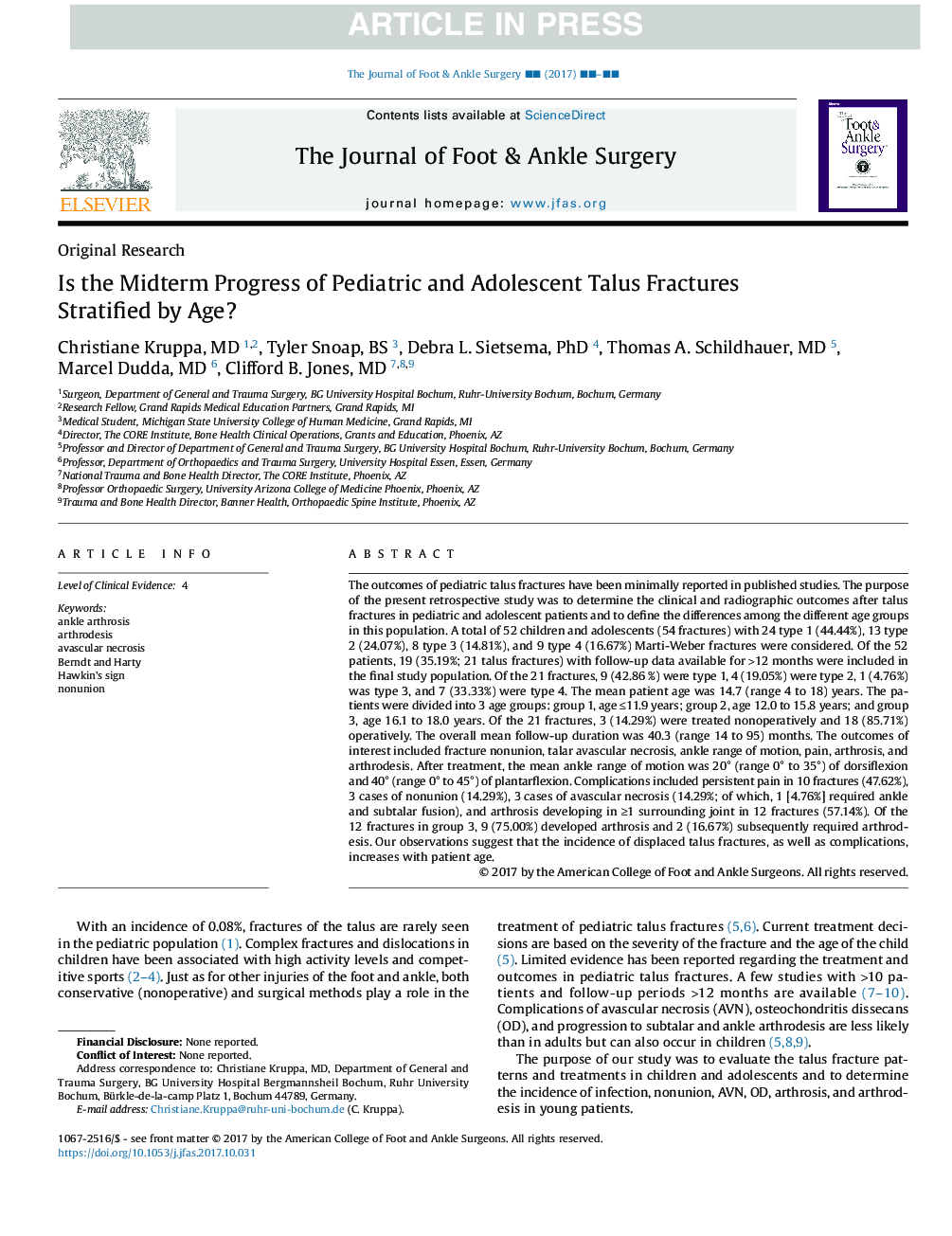| کد مقاله | کد نشریه | سال انتشار | مقاله انگلیسی | نسخه تمام متن |
|---|---|---|---|---|
| 8602989 | 1565511 | 2018 | 7 صفحه PDF | دانلود رایگان |
عنوان انگلیسی مقاله ISI
Is the Midterm Progress of Pediatric and Adolescent Talus Fractures Stratified by Age?
ترجمه فارسی عنوان
آیا پیشرفت میان دوره ای از شکاف های تالوس کودکان و نوجوانان طبقه بندی شده توسط سن است؟
دانلود مقاله + سفارش ترجمه
دانلود مقاله ISI انگلیسی
رایگان برای ایرانیان
کلمات کلیدی
موضوعات مرتبط
علوم پزشکی و سلامت
پزشکی و دندانپزشکی
ارتوپدی، پزشکی ورزشی و توانبخشی
چکیده انگلیسی
The outcomes of pediatric talus fractures have been minimally reported in published studies. The purpose of the present retrospective study was to determine the clinical and radiographic outcomes after talus fractures in pediatric and adolescent patients and to define the differences among the different age groups in this population. A total of 52 children and adolescents (54 fractures) with 24 type 1 (44.44%), 13 type 2 (24.07%), 8 type 3 (14.81%), and 9 type 4 (16.67%) Marti-Weber fractures were considered. Of the 52 patients, 19 (35.19%; 21 talus fractures) with follow-up data available for >12 months were included in the final study population. Of the 21 fractures, 9 (42.86 %) were type 1, 4 (19.05%) were type 2, 1 (4.76%) was type 3, and 7 (33.33%) were type 4. The mean patient age was 14.7 (range 4 to 18) years. The patients were divided into 3 age groups: group 1, age â¤11.9 years; group 2, age 12.0 to 15.8 years; and group 3, age 16.1 to 18.0 years. Of the 21 fractures, 3 (14.29%) were treated nonoperatively and 18 (85.71%) operatively. The overall mean follow-up duration was 40.3 (range 14 to 95) months. The outcomes of interest included fracture nonunion, talar avascular necrosis, ankle range of motion, pain, arthrosis, and arthrodesis. After treatment, the mean ankle range of motion was 20° (range 0° to 35°) of dorsiflexion and 40° (range 0° to 45°) of plantarflexion. Complications included persistent pain in 10 fractures (47.62%), 3 cases of nonunion (14.29%), 3 cases of avascular necrosis (14.29%; of which, 1 [4.76%] required ankle and subtalar fusion), and arthrosis developing in â¥1 surrounding joint in 12 fractures (57.14%). Of the 12 fractures in group 3, 9 (75.00%) developed arthrosis and 2 (16.67%) subsequently required arthrodesis. Our observations suggest that the incidence of displaced talus fractures, as well as complications, increases with patient age.
ناشر
Database: Elsevier - ScienceDirect (ساینس دایرکت)
Journal: The Journal of Foot and Ankle Surgery - Volume 57, Issue 3, MayâJune 2018, Pages 471-477
Journal: The Journal of Foot and Ankle Surgery - Volume 57, Issue 3, MayâJune 2018, Pages 471-477
نویسندگان
Christiane MD, Tyler BS, Debra L. PhD, Thomas A. MD, Marcel MD, Clifford B. MD,
